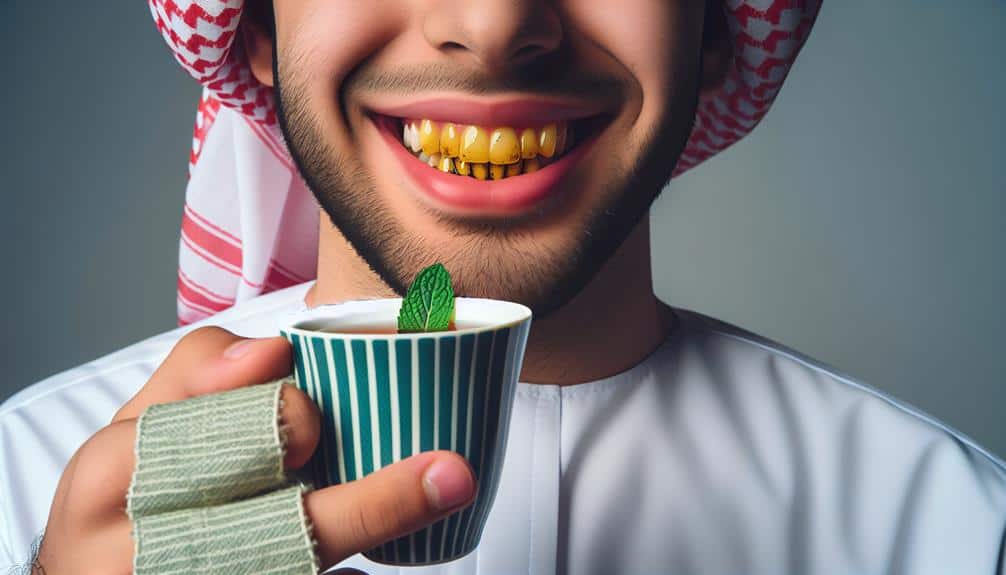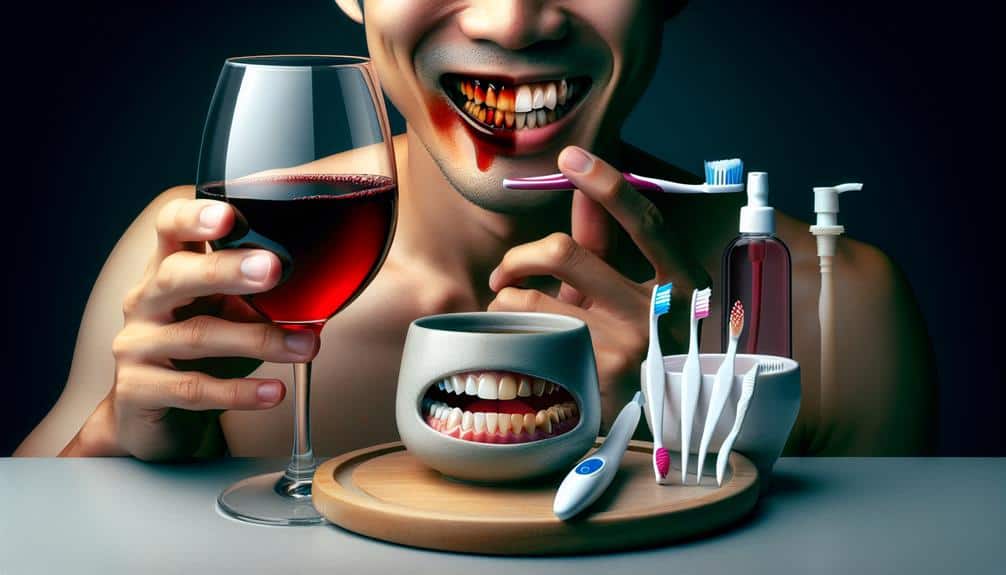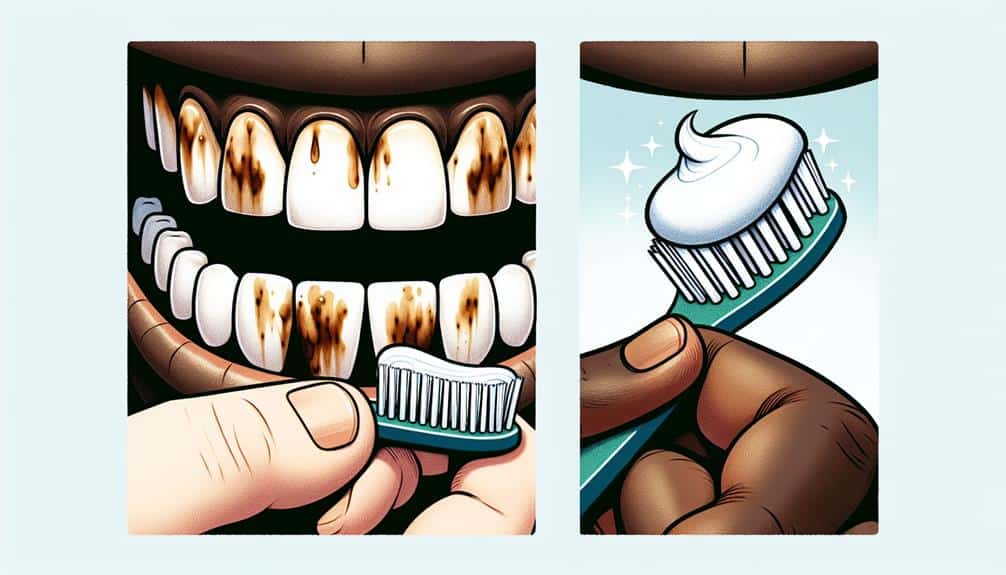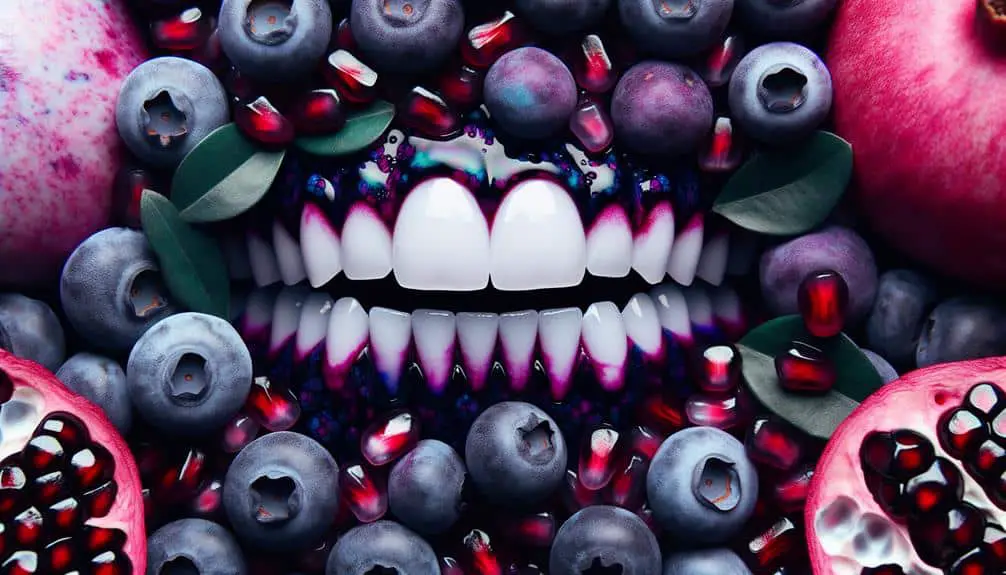Mint tea can cause your teeth to turn yellow because of its high acidity levels that wear away your enamel, revealing the yellow dentin beneath. The tannins present in mint tea also bind to proteins in your saliva and teeth, leading to stains. Maintaining good oral hygiene can help prevent these effects. Learning more about how mint tea affects teeth can help you make informed choices for your dental health.
Key Points
- Tannins in mint tea bind to enamel, causing yellow stains.
- Acidic nature of mint tea erodes tooth enamel, revealing yellow dentin.
- Increased tooth sensitivity due to enamel erosion from mint tea.
- Plaque formation promoted by tannins in mint tea.
- Mindful oral hygiene can help prevent teeth discoloration from mint tea.
Mint Teas Impact on Tooth Enamel
When consuming mint tea regularly, the natural acidity in the tea can gradually erode your tooth enamel, leading to yellow discoloration. Enamel erosion is a process where the outer layer of the tooth, the enamel, wears away due to acid attacks. The acids in mint tea weaken the enamel, making it more susceptible to staining and yellowing. As the enamel thins, the underlying dentin, which is naturally yellow, becomes more visible, contributing to the yellow appearance of the teeth.
Moreover, enamel erosion can lead to increased tooth sensitivity. When the enamel is eroded, the dentin and nerves inside the tooth become more exposed, causing discomfort or pain when consuming hot, cold, sweet, or acidic foods and beverages. This heightened sensitivity can impact your daily life and oral health.
To prevent enamel erosion and yellowing of teeth caused by mint tea, consider moderating your consumption, using a straw to minimize contact with teeth, or rinsing your mouth with water after drinking mint tea.
Tannins in Mint Tea
The presence of tannins in mint tea contributes greatly to the discoloration of teeth, especially when consumed regularly. Tannins are a type of polyphenol found in tea leaves, including mint tea, known for their astringent properties. When you drink mint tea containing tannins, these compounds can bind to proteins in your saliva and oral tissues. This binding process can lead to the formation of stains on the surface of your teeth, causing them to appear yellow over time.
Furthermore, tannins can also affect your dental health beyond just discoloration. These compounds have the potential to promote the growth of bacteria that contribute to plaque formation. As a result, the presence of tannins in mint tea can indirectly impact your overall oral hygiene and increase the risk of dental issues such as cavities and gum disease. Being mindful of the tannin content in mint tea and maintaining good oral hygiene practices can help mitigate the potential effects on your dental health.
Mint Tea and Teeth Discoloration
Yellowing of teeth due to the consumption of mint tea is a common concern among individuals who enjoy this aromatic beverage. When it comes to understanding why mint tea can lead to teeth discoloration, there are several factors at play:
- Dental Hygiene: Proper dental hygiene practices, such as regular brushing and flossing, can help mitigate the effects of tea staining on teeth.
- Tea Consumption Frequency: The more frequently you consume mint tea, the higher the likelihood of teeth discoloration over time.
- Tannins: Tannins present in mint tea can bind to the enamel of your teeth, leading to yellow stains.
- Acidity Levels: The acidity of mint tea can erode tooth enamel, making it more susceptible to staining.
Maintaining good dental hygiene practices, moderating tea consumption, and considering the impact of tannins and acidity levels are essential steps in preventing or reducing teeth discoloration caused by mint tea.
Preventing Yellow Stains From Mint Tea
To prevent yellow stains from mint tea, maintaining a consistent dental hygiene routine is essential. Oral hygiene plays a vital role in preventing tea stains on your teeth. Brushing your teeth at least twice a day with a fluoride toothpaste helps remove plaque and surface stains caused by mint tea. Flossing daily is equally important, as it helps eliminate food particles and plaque from between your teeth, preventing the buildup of stains. Additionally, using an antiseptic mouthwash can help reduce bacteria in your mouth that contribute to staining.
When consuming mint tea, consider using a straw to bypass direct contact between the tea and your teeth. This simple practice can minimize the exposure of your teeth to the staining compounds in the tea. Rinsing your mouth with water after drinking mint tea can also help wash away any residue that could lead to stains. By incorporating these oral hygiene practices into your routine, you can effectively prevent yellow stains from mint tea.
Whitening Options for Tea Stained Teeth
Consider exploring professional teeth whitening treatments to effectively address tea-stained teeth and restore a brighter smile. Tea stains can be stubborn, but with the right approach, you can achieve noticeable results.
Here are some options to help you whiten your teeth:
- In-Office Whitening: Professional treatments performed by a dentist can deliver quick and significant results, often in just one session.
- Take-Home Whitening Kits: Custom trays provided by your dentist allow you to whiten your teeth at home with professional-grade products.
- Laser Teeth Whitening: This advanced technique involves using a laser to enhance the whitening gel's action, providing faster and more efficient results.
- Combination Therapies: Some dental offices offer combination treatments that may include a mix of in-office procedures and at-home maintenance for the best whitening effects.
While professional treatments are effective, natural remedies like baking soda or activated charcoal may also help maintain your results. Consult with your dentist to determine the most suitable approach for your individual needs.
Frequently Asked Questions
Can Brushing Your Teeth Immediately After Drinking Mint Tea Prevent Yellow Staining?
Brushing your teeth immediately after drinking mint tea may not prevent yellow staining. Rinse with mouthwash, wait 30 minutes before brushing. Timing is key. Regular dental checkups protect enamel. Consult your dentist for personalized advice.
Does the Temperature of Mint Tea Have an Impact on Teeth Discoloration?
Imagine the warmth of mint tea meeting your lips. The temperature of mint tea can affect enamel. Hot tea may soften enamel, making it more vulnerable. Mint tea's acidity alters saliva pH, potentially contributing to discoloration.
Are There Any Specific Types of Mint Tea That Are Less Likely to Cause Yellowing of Teeth?
When choosing mint tea varieties, opt for lighter-colored herbal teas to reduce staining potential on your teeth. Some mint tea blends may be less likely to cause teeth discoloration compared to darker varieties.
Can Using a Straw While Drinking Mint Tea Help Prevent Teeth Staining?
When sipping mint tea, using a straw can be a smart move to prevent teeth staining. Your drinking habits play a role in dental care, so this simple step can aid in discoloration prevention.
How Long Does It Take for Teeth to Start Yellowing After Regularly Consuming Mint Tea?
Regular consumption of mint tea can lead to tea stains on your teeth. Depending on factors like oral hygiene and frequency of consumption, yellowing may start to occur within weeks to months.



